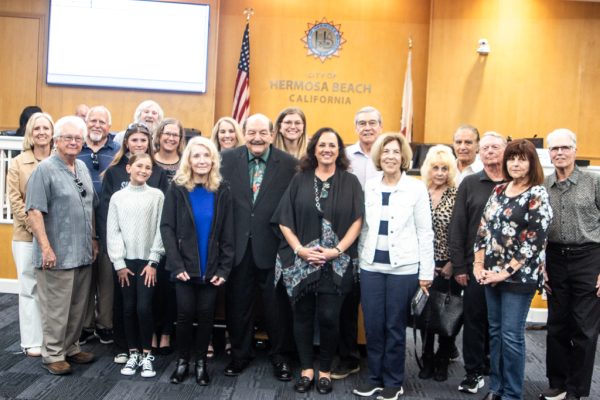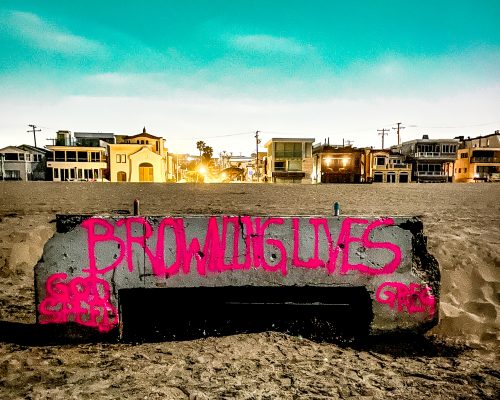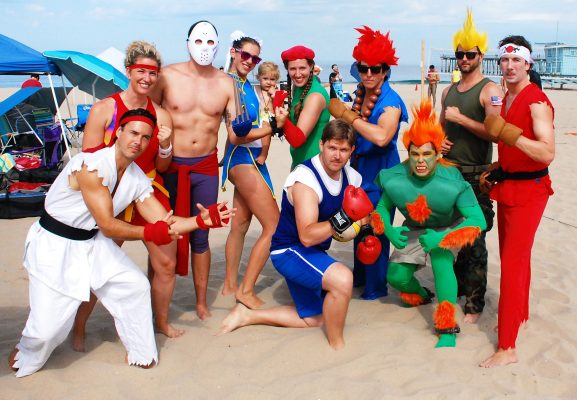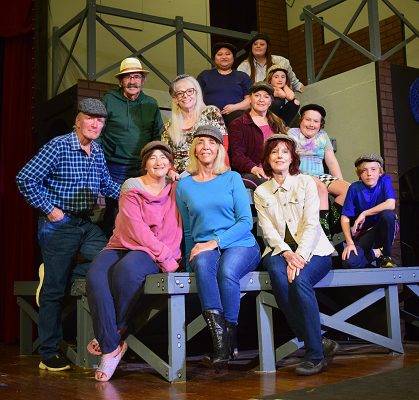In 1987 there were two Peruvian restaurants in Los Angeles, both located in unpromising strip malls. Mario’s, in a Hollywood strip mall, had been open for years. El Pollo Inka, in a Lawndale strip mall, had just opened their doors. Both were serving a cuisine that was puzzling to most Angelenos, and El Pollo Inka hadn’t initially planned to specialize in Peruvian food even though that’s where the owners came from. As their name suggests, they started as a rotisserie chicken specialist offering a few Andean items as a sideline, and added more when those turned out to be popular.
Thirty-seven years later, both of those restaurants are still open, and there are nine Pollo Inka locations. Peruvian cuisine has caught on in a big way, and the Hermosa Beach location of Pollo Inka is a great introduction for newcomers or a place for old hands to get their favorites. This branch has been open for two decades, next to the Trader Joe’s on PCH, and has changed over the years. The dazzling Andean murals that used to adorn one wall have been replaced by smaller and more sedate images. A display of folk-art masks on another wall gives the eerie impression that ancient gods are skeptically eyeing your table manners, but you get over it fairly quickly.
The menu at each branch of this chain is slightly different, and the selection at this one is smaller than the one at their original location — no surprise, as that one is at least three times the size. The favorites are here, and they reflect Peru’s multi-cultural heritage — Asian influenced stir fries, Italian spaghetti, and other items that show both European and indigenous influence, plus the rotisserie chicken they’ve been serving since the day they opened.
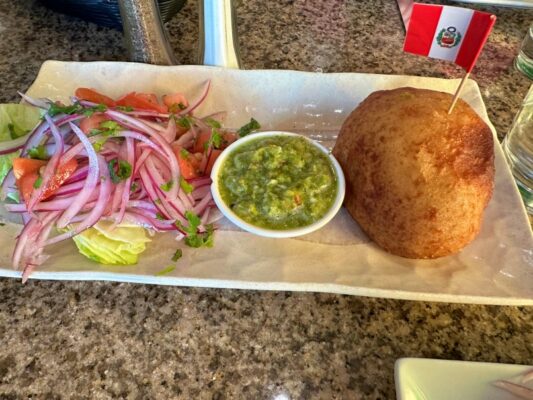
I have been visiting this location since they first lit the grill, and almost always get the same starter — papa Huancaina, slices of cold boiled potato topped with a tangy, spicy cheese sauce. On my recent visit with friends, we decided to ordered ceviche mercado, marinated whitefish topped with fried calamari, and papa rellena, a ball of mashed potatoes stuffed with ground beef, onion, tomato, olive, and raisins. Those who know Spanish food will recognize that mix of ingredients as picadillo, an item with variations all over Latin America. Cubans eat meat with olives and raisins over rice, Mexicans as a main course and in tacos, and Peruvians stuff it into potatoes. However you eat it, it has hints of fruit and vinegar from the olives along with meat and vegetables, and it’s delicious. A papa rellena here comes with a small salad and a cup of fiery green pepper sauce and is a nice starter for two or three, or light meal for one.
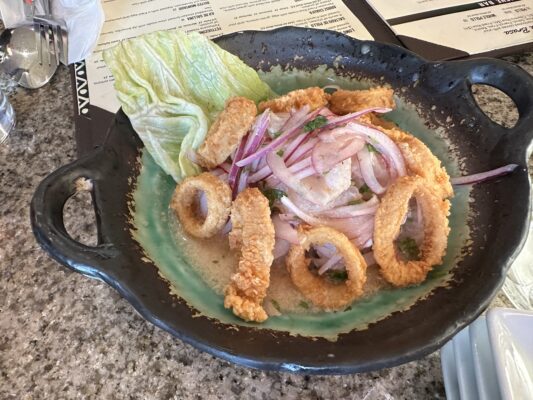
Peruvians and Mexicans both claim to have invented ceviche, but my money is on the Peruvians because it was first documented there in 1820, in what was then the national anthem. Ceviche in Peru is made with many kinds of seafood and ranges from gently tart and delicately spicy to searingly hot, The version served here is on the mild side with a little pepper kick. The calamari rings were not an integral part of the flavor, but they were a nice textural component to the generous portion of fish and onions pickled in lime juice.
As much as we like some of the other appetizers, we didn’t order them because the portions of main courses are substantial, and all meals also include a bowl of aguadito. This chicken soup with rice, corn, and potatoes flavored with cilantro, citrus, and chillies is a delight, and my wife often orders it as a meal. She decided on basil linguine topped by a quarter rotisserie chicken this time, while the rest of us had pasta with seafood, seafood rice, and the intimidatingly named pescado a lo macho. Calling anything “a lo macho” usually means someone in the kitchen wants to see how hot they can make something, but while this dish of seafood in a creamy yellow pepper sauce has a definite kick, it doesn’t set a four alarm fire on your tongue. It reminds me of Indian yellow curries, with the same rich mélange of flavors with no one spice dominating, and if you like those then this is a must-order. If this isn’t spicy enough for you, they have three hot sauces available, which range from milt to sweat-inducing.
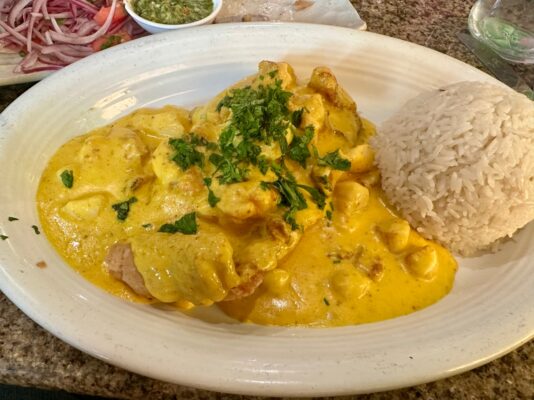
Linguine (called spaghetti on the menu, no doubt to the indignation of purists of culinary lexography) arrived in Peru with waves of Italian immigrants in the 1860s when the city-states of Italy were embroiled in wars. Once in South America, local ingredients were incorporated in many dishes, but the creamy spinach and basil pesto served here is fairly close to the home cooking of Genoa. It’s a fine companion to scallops, shrimp, squid, and chunks of fish in the tallarin verde de mariscos, and as a complement to the rotisserie chicken. That chicken is marinated in a citrus and purple corn mix before roasting and is among the best in a neighborhood with plenty of competition. It doesn’t have a wood smoke flavor because they switched to cooking with gas here, but it’s still excellent.
The arroz con mariscos is the Peruvian equivalent of a Spanish paella, but with differences — the rice is cooked in a broth with cilantro rather than with saffron, and instead of sausage or bell peppers there are bits of corn, peas, and carrots in the mix. The plentiful bowl of seafood and rice is topped with one jumbo prawn in shell and a very large clam, and is a feast at only 20 dollars.
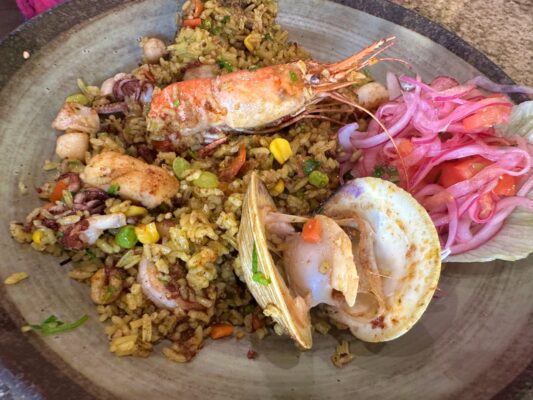
El Pollo Inka has a short list of wines and beers, plus some low-alcohol tequila cocktails that are a relatively new addition to the menu. We tried margaritas variations that included passion fruit puree, mango juice, and fresh strawberries, and found them all to be refreshing. Those who don’t drink alcohol may prefer chicha, the purple corn and citrus punch that contains cinnamon and nutmeg.
We finished the meal with alfajores, shortbread and nut cookies sandwiched with a mix of dulce de leche. As generously portioned as the meals are here, we always save room for those because they’re a family favorite.
A very large dinner for four with appetizers and drinks ran just over $40 per person, a modest amount for the quality and quality we consumed. El Pollo Inka has earned their star in the South Bay dining firmament, a local startup that has made their mark in the broader dining scene.
El Pollo Inka is at 1100 PCH in Hermosa Beach. Open daily 11 a.m. — 9 p.m.Parking lot. Wheelchair access good. Some vegan items. Beer and wine served. Noise level moderate. (310) 372-1433. ElPolloinkahermosa.com. ER



